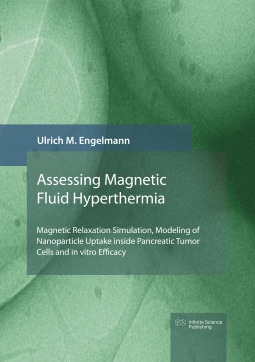Assessing Magnetic Fluid Hyperthermia
Magnetic Relaxation Simulation, Modeling of Nanoparticle Uptake inside Pancreatic Tumor Cells and in vitro Efficacy
Abstract
As a leading cause of death worldwide with patient-specific evolving mutations, cancer requires innovative therapies capable of individualized treatment. The use of magnetic nanoparticles (MNP) as thermal agents offers such individualized cancer therapy: After local accumulation at the tumor site, MNP can be triggered to transform the energy of an externally applied alternatingmagnetic into heat via relaxation of their magnetic moments. This process named magnetic fluid hyperthermia (MFH) enables organ-confined cancer treatment by delivering therapeutic temperatures higher than 43 °C inside tumors, inducing tumor cell death. In this way, MFH efficacy relies on MNP efficiency to generate such elevated temperatures in interaction with the biological environment. However, this environment imposes severe limitations to the MNP magnetic relaxation and heating behavior by restricting the MNP mobility and causing MNP agglomeration. Based on in vitro experiments, this thesis addresses the applicability of MFH to pancreatic tumor cells and discusses opportunities to optimize intracellular MNP heating for clinical application of MFH. The interaction of iron oxide MNP with pancreatic tumor cells and the MNP uptake kinetics inside these cells are investigated using transmission electron microscopy and magnetic particle spectroscopy. The impact of MNP-cell interaction on heating efficiency is quantified with inductive heating experiments and compared to artificially agglomerated and immobilized MNP, mimicking the conditions in cellular environments. Furthermore, Monte-Carlo (MC-)simulations of MNP magnetic relaxation are used to predict sets of parameters varying field amplitude and frequency as well as MNP size and magnetic properties to optimize MFH efficiency under medically tolerable field parameters. Combined agglomeration and immobilization of MNP upon internalization inside cells decrease heating efficiency by nearly two thirds compared to freely dispersed MNP. This decrease is attributed to one half (one third of the overall heating) to the inhibition of physical rotation upon MNP immobilization, blocking the Brownian contributions of larger MNP to overall heating. The other half can be related to demagnetization effects due to increased magnetic interparticle interactions upon MNP agglomeration. Despite this decrease in MNP heating, MFH can still effectively damage cell in vitro even without a perceptible bulk temperature rise, by local heating on the cellular level. This requires a sufficiently large MNP uptake inside cells, which is reached after approx. 6 h of incubation as predicted from MNP uptake modeling. The cell damage depends on the thermal energy deposited per cell (TEC). Interestingly, healthy cells are more resistant to MFH treatment with a 50% margin in TEC to damage healthy cells compared to pancreatic tumor cells. As a consequence, MFH therapy can be tuned to deal tumorspecific damage while healthy surrounding cells remain unharmed by controlling TEC via the intracellular uptake of MNP, the MNP heating efficiency and the duration of MFH treatment. The improvement of intracellular MNP uptake and heating efficiency, e. g. by using MNP with large particle cores (dC 25 nm) as predicted by MC-simulations, will therefore remain one focus of future work. It seems most important, however, to translate MFH to in vivo experiments in the near future to establish MFH among the standard clinical cancer therapies.
The download file provided is an excerpt only. The complete book can be found here.


